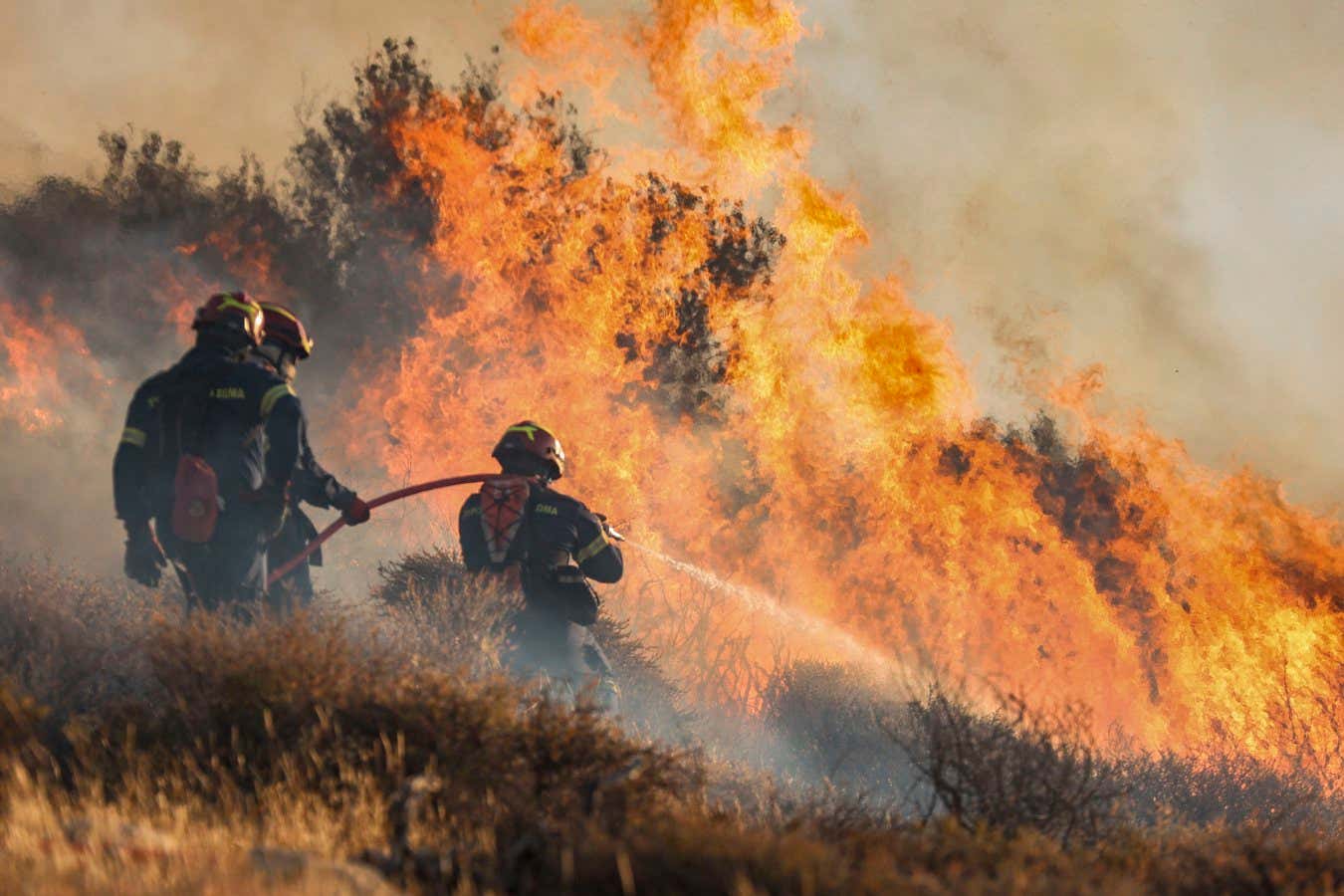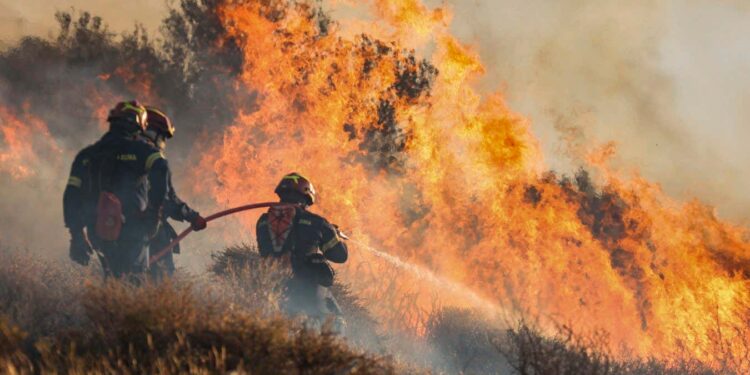
Wildfires are expected to become more frequent and severe as global temperatures rise
COSTAS METAXAKIS/AFP via Getty Images
If you told a child to stay “well away” from a cliff edge, how close to the edge could they creep before you started shouting for them to turn back? That is the question puzzling climate scientists right now, as it looks almost certain that we will breach the global commitment to limiting warming to no more than 1.5°C above pre-industrial levels. As we enter the danger zone, what comes next?
“Governments have set themselves 1.5°C targets. But what those mean in a world where we’re already past 1.5°C is harder and harder to understand,” says Robin Lamboll at Imperial College London. “I think it would be very helpful if people started talking much more concisely and concretely about the actual goals they have in mind.”
Those national targets are derived from the international Paris Agreement, which was signed in 2015 and is a vague starting point for defining climate limits. The text formally commits countries to “pursuing efforts” to limit warming to 1.5°C and to holding any temperature increase to “well below” 2°C. But how low is “well below”?
“The wording of the long-term temperature goal of the Paris Agreement is both a solution and a challenge,” says Joeri Rogelj, also at Imperial College London. “The solution is that this was the wording that countries could agree to. The challenge is that it leaves room for interpretation.”
Rogelj fears that unless the meaning of “well below” 2°C is clarified – and swiftly – there is a risk that the world simply takes 2°C as the new line in the sand. The trouble is, many scenarios for achieving 2°C only provide a 50 per cent chance of success, meaning that aiming for this line could still see us vastly overshooting it.
To address this, Rogelj and Lamboll point out that international agreements are generally required to use a normal understanding of words. So, if the Paris Agreement promises to keep temperatures well below 2°C, the pair argue that most people wouldn’t expect a significant risk of overshoot to be compliant with that promise.
Yet as things stand, two model scenarios might both claim to limit warming to below 2°C, but one might offer just a 66 per cent chance of remaining below the limit, while the other offers a 90 per cent chance. “People are not very good at dealing with probabilities,” says Lamboll. “A 66 per cent chance and a 90 per cent chance are incredibly different things.”
This uncertainty arises from different assumptions underlying the scenarios, with those requiring a stricter control on emissions having a better chance of remaining below 2°C. The pair argue that peak temperature – the most the world is likely to warm before any mitigation measures kick in to bring temperatures down – better captures the differences between scenarios and so provides a clearer boundary for climate goals.
In unpublished work, Rogelj and Lamboll assessed four 2°C climate model scenarios, calculating for each the median peak temperature required to stay below 2°C with a 66 per cent, 83 per cent and 90 per cent chance. For example, one scenario shows that for a 66 per cent chance of staying below the limit, temperatures should peak at about 1.83°C, but for a 90 per cent chance they would need to peak at 1.54°C.
Looking across all of the models, the pair conclude that, to offer the world an 83 per cent chance of remaining below 2°C of warming – a fair representation, they say, of the promise to remain “well below” the threshold – the median temperature can’t peak beyond 1.63 to 1.67°C, the range given by all of the models.
Other researchers are coming to the same conclusion. Gottfried Kirchengast and Moritz Pichler, both at the University of Graz in Austria, recently proposed 1.7°C as the peak temperature limit to keep us “well below 2°C”, because it is in line with Intergovernmental Panel on Climate Change’s projections that give an 83 per cent chance of remaining below 2°C.
“The 1.5°C is a clear guard rail. [Defining] 1.7°C would make ‘well below 2°C’ a clear guard rail,” says Kirchengast. This new “upper limit” of warming would help policy-makers calculate their remaining emissions budgets and plan transition pathways accordingly, he argues. “Policy needs these guidelines.”
How difficult would that target be to meet? Limiting warming to 1.7°C is certainly extremely ambitious, given that current policies put the world on track for 2.6°C of warming by the end of the century, yet it isn’t completely fanciful. The most optimistic scenario, assuming every country diligently fulfils all of its climate promises, suggests warming would stabilise at 1.9°C by the end of the century, according to a recent United Nations assessment. Getting to 1.7°C would require going beyond existing promises.
But even if some scientists are starting to cluster around the idea that “well below” 2°C actually means a peak temperature limit of about 1.7°C, many people are opposed to codifying a post-1.5°C goal.
We still don’t understand the climate system well enough to be confident that we can aim for such specific warming levels, says Carl-Friedrich Schleussner at Berlin-based climate science institute Climate Analytics. There is still considerable uncertainty over how sensitive Earth’s systems are to greenhouse gas emissions, which could mean the planet will warm much faster than expected. “We need to be careful not to be overconfident,” he cautions. Setting a specific temperature goal “conveys the message that we know exactly where we are going, which is not the case”, he says.
Instead, Schleussner believes the focus should be on holding governments accountable for any failure of the 1.5°C target, such as by calculating the “carbon debt” accumulated by nations as they exceed that warming threshold. “Unless we are able to establish accountability for failing to limit warming to 1.5°C, I think we are failing the Paris Agreement,” he says.
Lower-income nations, particularly the small island states that battled for the inclusion of the 1.5°C temperature goal into the Paris Agreement, are also likely to fiercely resist any attempt to recalibrate global climate ambition to a new target. Ilana Seid, Palauan ambassador to the UN and chair of the Alliance of Small Island States (AOSIS), a UN negotiating bloc, says rising sea levels and the die-off of coral reefs expected at warming above 1.5°C are an existential threat to the countries she represents.
“For AOSIS, the number is 1.5°C. That’s our rallying call,” says Seid. “There are important reasons for us to be below or at 1.5°C, and that’s where we are sticking to… Anything else is just a distraction.”
Natalie Unterstell, a former UN climate negotiator for Brazil who is now at climate policy think tank Talanoa, says a shift to adopting a global goal of no more than 1.7°C of warming would “signal to governments and markets that failure is acceptable”.
“Shifting the goalposts while we’re still in the game only helps the laggards and lobbyists. It fractures political will, confuses public messaging and risks normalising climate failure,” she says. “A new temperature target now would create precisely the kind of cognitive fog that fossil fuel interests are counting on.”
“The 1.5°C limit is not just a symbolic threshold but a life-or-death line for billions,” says Unterstell. “So if anything, this is the moment to double down on action, not downgrade our goals.”
Besides the ethical concerns about a move to adopt a new global goal, practically speaking it would be tremendously difficult to codify 1.7°C into the UN climate system, she points out, requiring a reopening of the rulebooks governing the Paris Agreement and the unanimous support of all 200+ member states. This is unlikely to be an objective at the upcoming COP30 summit in Belem, Brazil, later this year, although the Brazilian presidency will be under pressure to extract bolder climate plans from polluting nations at the summit to close the “ambition gap” between 1.5°C and current warming trajectories.
But should this debate be framed as a contest between 1.5°C and a new, slightly less stringent goal? For Rogelj, limiting warming to 1.5°C will remain an enduring key global target, even if a new temperature goal is also introduced. “1.5°C will never die, the target will remain,” he says. “That is because the target is to ‘pursue efforts’ towards limiting warming to 1.5°C. Having exceeded 1.5°C doesn’t take away the goal of pursuing efforts to limit warming to 1.5°C.”
When the Paris Agreement was drawn up in 2015, limiting warming to 1.5°C was ambitious but achievable. Now, vanishingly few climate models show a realistic route to meeting this goal without at least some “overshoot” – temperatures rising above 1.5°C for a few decades before being brought back below the limit by the end of the century, using technology like carbon capture. The move to clarify the precise meaning of “well below 2°C” isn’t necessarily to provide a replacement target for 1.5°C, but to set an upper temperature threshold for warming in a scenario where the world overshoots, then bring warming back to the 1.5°C limit, says Rogelj.
The question for policy-makers now is this: if 1.5°C is the safety line and 2°C is the cliff edge, how far into the danger zone should we be willing to stray?
Topics:
- Paris climate summit/
- carbon emissions
Source link : https://www.newscientist.com/article/2488575-is-it-time-to-aim-for-1-7c-as-the-new-limit-for-global-warming/?utm_campaign=RSS%7CNSNS&utm_source=NSNS&utm_medium=RSS&utm_content=home
Author :
Publish date : 2025-07-18 12:00:00
Copyright for syndicated content belongs to the linked Source.








